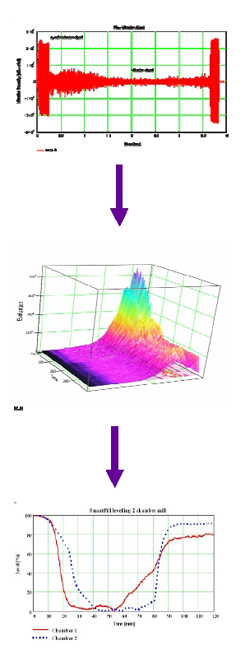Smart Fill Level Control (Continued)
(continued)
Advantages:
•Interference free measurement, no influence from other mills or machines, which are located in the same hall.
•Significantly enhanced precision of measurement
•Considerably reduced wearout of balls and liners
•Enhanced throughput of the mill
•Seamless connection to any automation or control system
•Autonomous energy supply no battery required
•Direct cement temperature measurement in the diaphragm
Features to optimise grinding processes:
•Easy installation
•Automatic calibration
•Very easy start up
•Up to three independent sensors per mill
•Up to eight systems in one hall
Principle of operation:
Structure borne sound in the mill‘s shell contains much more information than the airborne sound which is radiated by the mill.
To use this additional information in optimum, a new nonlinear algorithm was developed, which evaluates these signals and extracts fill level and other measurement categories at level of precision and reliability, which was unknown up to date.
Evaluation is performed by means of modern methods of nonlinear dynamics.
3-dimensional pattern of sound signatures are produced during every revolution of the mill. Special areas (e.g. ball hitting point) are searched automatically and a proportion of level is evaluated.
This combination of high performance sensor elements and new mathematical methods is very precise and reliable. In addtion to this, the lateral resolution is extremely high. The level of the first and
second chamber of a mill can be very clearly distinguished.
Attachments
■
Smart Fill Level Control (Continued)
(continued)
Applications
Due to the extremely high precision of fill level measurement, now it is possible to keep the level constantly at its optimum using closed loop control systems.
This saves a lot of energy and enhances throughput of the mill and quality significantly.
SmartFill can be used on every type of ball mill in the mineral industries (cement mills, raw mills, coal mills, ore mills . . .)
Each SmartFill system has three measurement channels, which can be used freely for level or temperature. Thus raw mills with three chambers can be measured as well as cement mills with two
chambers and one temperature signal from the diaphragm using one system only.
For coal mills an ATEX certified version is available (see special brochure).
Up to eight systems may be operated in one hall. If several halls are available each one is equipped individually.
All signals are transfered to the PLC or automation system of the plant via 4...20 mA current loops.
Smart Fill can be supplemented by following products:
Combined with the Fuzzy-Expert-System
SmartMillControl the electronic ear will
drive your mill constantly at optimum level
(see:

href="https://forum.bulk-online.com/showthread.php?threadid=12147" target="blank">https://forum.bulk-online.com/showth...threadid=12147 )
Controlling the cement temperature in the mill:
Use SmartFill‘s temperature option and a closed
loop controller
Automatic calibration for up to 16 cement types:
hard– and software module to adapt calibration
to very different cements
KIMA Echtzeitsysteme GmbH was founded 1996 in Jülich Germany. A highly motivated team of engineers, software developers, physicists and technicians is working on high performance solutions and building blocks, which can be tailored to be used in various process applications.
KIMA is a highly qualified contact for all puposes of advanced measurement and control systems for the process industries.
The cement industry is one focal point of our work. KIMA Fuzzy-logic controllers are operating and controlling mills, complete grinding plants and kilns for more than 10 years. They achieve highest efficiency, optimum availability and smooth operation, thus enabling high product quality and durability of machinery.
The market launch of „SmartFill“, a high perfomance, high precision level measurement system for ball mills in 2003 was a milestone in the history of the company.
KIMA solutions are also used in food, chemical, waste water industries, as well as in mechanical engineering, and for oil production.
For more information, please visit:

href="https://edir.bulk-online.com/profile/8884-kima-echtzeitsysteme.htm" target="blank">https://edir.bulk-online.com/profile...eitsysteme.htm
Attachments
■




Smart Fill Level Control
Smart Fill
Interference-free “electronic ear“ for measurement of level and temperature in ball mills
Even today, when it comes to comminution of large masses, ball mills are the work horses in the mineral industries.
In the past the filling level of ball mills was to be determined by the use of specialized microphone schemes (“electronic ears“), which however showed a series of significant disadvantages (strong interference due to other aggregates in the same hall, low precision, poor reliability)
All problems of these “classical“ fill level measurement methods are solved by the new “electronic ear“ produced by KIMA, which uses a different operating principle. A structure borne sound sensor is attached directly on the shell of the rotating mill. It acquires all sounds which occur in the metal wall. Noise and sounds produced by other mills or machines are completely ignored by this sensor, as it is totally insensitive to airborne sound. The signals are transmitted wireless to an industrial
PC which analyzes them by means of methods of nonlinear dynamics.
KIMA‘s electronic ear only senses structure borne sound. Thus every type of airborne sound, which is produced by other aggregates does not influence the result of the measurement.
Moreover, direct measurement at the mill shell enables the recovery of additional information about the current state of balls, liners and diaphragm.
Up to three sensors can be connected to one electronic unit (On Mill Unit).
Therefore it is possible to measure simultaneously the level of each chamber of two-chamber mills with high resolution and independent of each other.
The third input can be used for an additional temperature sensor, which can measure the cement temperature direct in the diaphragm.
The On Mill Unit contains its own energy supply, which gains its energy out of the rotation of the mill. This completely avoids regular change of batteries or complex installations (inductive loops or the like).
Attachments
smartfill_1 (JPG)
■